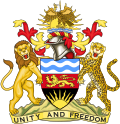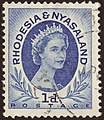In the Commonwealth realms, a Royal Style and Titles Act or a Royal Titles Act is an Act of Parliament passed in the relevant jurisdiction which defines the sovereign's formal title in that jurisdiction. The most significant of these acts is the Royal and Parliamentary Titles Act 1927 of the United Kingdom, which recognised the creation of the Irish Free State, a development that necessitated a change in King George V's title.

Elizabeth II was Queen of Malta as head of state of Malta from 1964 to 1974. Malta was an independent sovereign state and a constitutional monarchy, sharing a monarch with other Commonwealth realms, including the United Kingdom. Elizabeth's constitutional roles in Malta were mostly delegated to a governor-general.

The monarchy of Solomon Islands is a system of government in which a constitutional monarch is the head of state of Solomon Islands. The present monarch and head of state, since 9 September 2022, is King Charles III, who is also the head of state of fourteen other Commonwealth realms. Although the person of the sovereign is equally shared with 14 other independent countries within the Commonwealth of Nations, each country's monarchy is separate and legally distinct. As a result, the current monarch is officially titled the King of Solomon Islands and, in this capacity, he and other members of the royal family undertake public and private functions domestically and abroad as representatives of Solomon Islands. However, the King is the only member of the royal family with any constitutional role.

The monarchy of Antigua and Barbuda is a system of government in which a hereditary monarch is the sovereign and head of state of Antigua and Barbuda. The current Antiguan and Barbudan monarch and head of state since 8 September 2022, is King Charles III. As sovereign, he is the personal embodiment of the Crown of Antigua and Barbuda. Although the person of the sovereign is equally shared with 14 other independent countries within the Commonwealth of Nations, each country's monarchy is separate and legally distinct. As a result, the current monarch is officially titled King of Antigua and Barbuda and, in this capacity, he and other members of the Royal Family undertake public and private functions domestically and abroad as representatives of Antigua and Barbuda. However, the King is the only member of the Royal Family with any constitutional role.

The Cook Islands are a constitutional monarchy within the Realm of New Zealand. Under the Cook Islands Constitution, the Sovereign in Right of New Zealand has been Head of State of the Cook Islands since 4 August 1965. The Sovereign is represented by the King's Representative; as such, the King is the de jure head of state, holding several powers that are his alone, while the King's Representative is sometimes referred to as the de facto head of state. The viceregal position is currently held by Tom Marsters.
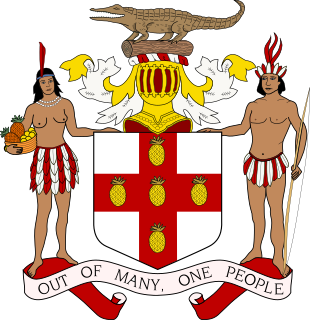
The monarchy of Jamaica is a constitutional system of government in which a hereditary monarch is the sovereign and head of state of Jamaica. The terms Crown in Right of Jamaica, His Majesty in Right of Jamaica, or The King in Right of Jamaica may also be used to refer to the entire executive of the government of Jamaica. Though the Jamaican Crown has its roots in the British Crown, it has evolved to become a distinctly Jamaican institution, represented by its own unique symbols.
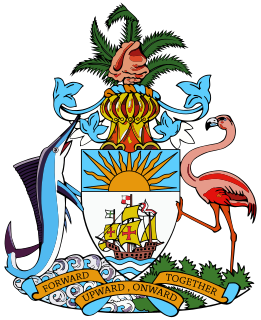
The monarchy of the Bahamas is a system of government in which a hereditary monarch is the sovereign and head of state of Commonwealth of the Bahamas. The current Bahamian monarch and head of state since 8 September 2022, is King Charles III. As sovereign, he is the personal embodiment of the Bahamian Crown. Although the person of the sovereign is equally shared with 14 other independent countries within the Commonwealth of Nations, each country's monarchy is separate and legally distinct. As a result, the current monarch is officially titled King of the Bahamas and, in this capacity, he and other members of the royal family undertake public and private functions domestically and abroad as representatives of the Bahamian state. However, the King is the only member of the Royal Family with any constitutional role.

The monarchy of Grenada is a system of government in which a hereditary monarch is the sovereign and head of state of Grenada. The present monarch is King Charles III, who is also Sovereign of a number of the other Commonwealth realms. The King's constitutional roles are mostly delegated to the Governor-General of Grenada. Royal succession is governed by the English Act of Settlement of 1701, which is part of constitutional law.

The monarchy of Saint Vincent and the Grenadines is the constitutional system of government in which a hereditary monarch is the sovereign and head of state of Saint Vincent and the Grenadines, forming the core of the country's Westminster-style parliamentary democracy. The Crown is thus is the foundation of the executive, legislative, and judicial branches of the Vincentian government. While Royal Assent and the royal sign-manual are required to enact laws, letters patent, and orders in council, the authority for these acts stems from the Vincentian populace, and, within the conventional stipulations of constitutional monarchy, the sovereign's direct participation in any of these areas of governance is limited, with most related powers entrusted for exercise by the elected and appointed parliamentarians, the ministers of the Crown generally drawn from amongst them, and the judges and Justices of the Peace.

Uganda became an independent sovereign state on 9 October 1962. The British monarch, Elizabeth II, remained head of state as Queen of Uganda until the link with the British monarchy was severed on 9 October 1963 and the Kabaka (King) of Buganda, Sir Edward Mutesa II, became the first President of Uganda.
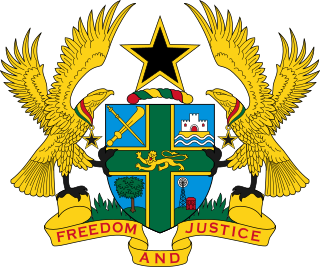
Elizabeth II was Queen of Ghana from 1957 to 1960, when Ghana was an independent sovereign state and a constitutional monarchy. She was also queen of the United Kingdom and other sovereign states. Her constitutional roles in Ghana were delegated to the governor-general of Ghana.

From 1960 to 1963, Nigeria was a sovereign state and an independent constitutional monarchy. Nigeria shared the monarch with Australia, Canada, United Kingdom, and certain other sovereign states. The monarch's constitutional roles were mostly delegated to the governor-general of Nigeria.
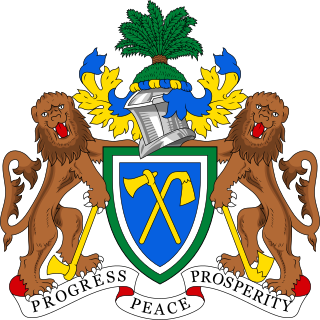
Elizabeth II was Queen of the Gambia from 1965 to 1970, when the Gambia was an independent sovereign state and a constitutional monarchy within the Commonwealth of Nations. She was also the monarch of the other Commonwealth realms, including the United Kingdom. Her constitutional roles in the Gambia were delegated to the governor-general.

Elizabeth II was Queen of Guyana from 1966 to 1970, when Guyana was independent sovereign state with a constitutional monarchy. She was also the sovereign of the other Commonwealth realms, including the United Kingdom. Her constitutional roles were delegated to the governor-general of Guyana.

Elizabeth II was Queen of Kenya from 1963 to 1964, when Kenya was an independent sovereign state with a constitutional monarchy. She was also the sovereign of the other Commonwealth realms, including the United Kingdom. Her roles as the Kenyan head of state were delegated to the governor-general of Kenya.

Elizabeth II was Queen of Mauritius as well as its head of state from 1968 to 1992 when Mauritius was an independent sovereign state and a constitutional monarchy within the Commonwealth of Nations. She was also the monarch of other Commonwealth realms, including the United Kingdom. Her constitutional roles in Mauritius were delegated to a governor-general. Mauritius became a republic in 1992.

Elizabeth II was Queen of Uganda as well as the head of state of Uganda from 1962 to 1963, when the country was an independent constitutional monarchy. She was also the sovereign of other countries in the Commonwealth of Nations, including the United Kingdom.
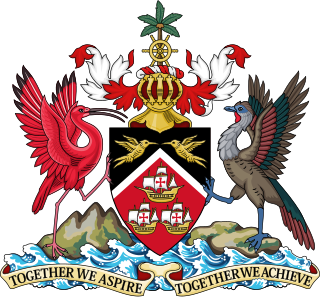
The Queen of Trinidad and Tobago was the head of state from independence in 1962 until the abolition of the monarchy in 1976. The monarch's constitutional roles were delegated to a governor-general, who acted on the advice of government ministers.

Elizabeth II was Queen of Tanganyika from 1961 to 1962, when Tanganyika was an independent sovereign state and a constitutional monarchy. She was also the monarch of other sovereign states, including the United Kingdom. Her constitutional roles in Tanganyika were mostly delegated to the governor-general of Tanganyika.
